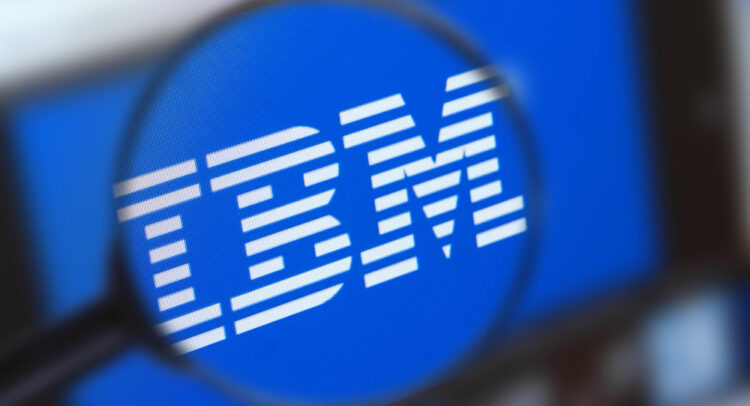International Business Machines (IBM) stock slumped following a strong second-quarter earnings report, leaving some investors perplexed. Despite revenue rising 8% year-over-year, combined with an expectations-beating EPS of $2.80, IBM has fallen over 7% so far today due to soft Q3 guidance and underwhelming financial performance in its Software segment. However, a bit of a comeback is underway as value investors realize IBM’s bargain-basement proposition.
Elevate Your Investing Strategy:
Take advantage of TipRanks Premium at 50% off! Unlock powerful investing tools, advanced data, and expert analyst insights to help you invest with confidence.

A closer look reveals that these changes likely reflect transient macroeconomic impacts rather than a fundamental flaw in IBM’s business. Subsequently, IBM remains strategically positioned to benefit from the ongoing AI boom, making me Bullish on its stock.
Diving into IBM’s Strategic Growth Drivers
Importantly for IBM bulls, the computing giant reported robust growth in several segments. Its legacy segment, Infrastructure, was the strongest performer in Q2, rising 13.6% year-over-year to $4.14 billion. However, the company’s Software segment fell short of expectations, despite seeing revenue increase 10% year-over-year to $7.39 billion.
IBM CEO Arvind Krishna attributed the underperformance to its clients prioritizing hardware investments in light of macroeconomic and trade uncertainties. Critically, the sub-segments within software still recorded healthy double-digit gains. IBM’s Hybrid cloud (Red Hat) and Automation were up 16% year-over-year. Recall that IBM acquired Red Hat for a massive $34 billion to expand upon its “hybrid multicloud platform,” which IBM described as an “interconnected public and private cloud environment.”
One key takeaway is that IBM’s software segment remains well-positioned to capitalize on the AI boom, despite near-term challenges. As enterprises invest in hardware infrastructure, the demand for complementary software solutions—where margins are significantly higher—is set to grow, enhancing IBM’s long-term prospects.

Meanwhile, IBM’s consulting segment recorded modest year-over-year revenue growth of 3%, reaching $5.31 billion and topping Wall Street’s estimate of $5.16 billion. This reflects growing demand from companies seeking guidance on integrating AI into existing systems and optimizing their IT operations.
IBM’s Decline Could be an Opportunity in Disguise
For IBM bulls, yesterday’s Q2 earnings market stumble is an opportunity in disguise. IBM’s 49.2 P/E ratio, which trades at a 69% premium to the IT sector median, is a notable statistic implying a significant valuation premium for IBM.

IBM has nursed a modest P/E in the low teens for decades. Indeed, the premium valuation is due to IBM’s position in a tech market increasingly defined by AI. IBM is executing a “land and expand” strategy in AI, using its strengths in hardware—particularly mainframes—and its hybrid cloud platform via Red Hat as entry points. The goal is to drive long-term demand for its higher-margin AI software and consulting services.
While the market’s initial reaction may seem short-sighted, it’s also shaped by sky-high expectations. With AI leaders like Nvidia (NVDA) consistently crushing earnings projections, any sign of slowing revenue growth or rising costs is met with sharp scrutiny.
What stands out to me in the long term is IBM’s ability to leverage its deep roots in enterprise computing to carve out a meaningful position in AI. This shift is breathing new life into its legacy operations, transforming them from just stable, cash-generating assets into growth drivers. At the same time, IBM’s push into software opens up another compelling growth avenue once the foundational infrastructure is in place.
Is IBM a Buy, Hold, or Sell?
On Wall Street, IBM earns a Moderate Buy consensus rating based on eight Buy, four Hold, and two Sell ratings in the past three months. IBM’s average stock price target of $288.43 implies ~10% upside potential over the next twelve months.

Earlier this week, Bank of America analyst Wamsi Mohan assigned IBM a Buy rating with a price target of $320. The analyst noted that “while there are decelerating trends in certain areas of IBM’s business, the company is seen as a defensive investment with potential for improved revenue growth. This growth is expected to enhance cash flows, which could be reinvested in mergers and acquisitions, further strengthening IBM’s position.”
IBM Crawls Towards AI and Hybrid Cloud Growth
My analysis suggests that the market’s initial reaction to IBM’s Q2 earnings was largely driven by elevated expectations. It reflects the inherent tension between IBM’s long-term strategic pivot toward hybrid cloud and AI, and the market’s demand for steady top-line growth and expanding margins. Still, IBM’s revitalized Infrastructure segment is laying a solid foundation for future growth in its Software and Consulting divisions.
That said, tangible risks are lurking. The transition from infrastructure to high-margin software and services won’t happen automatically — strong execution is essential. Additionally, IBM remains exposed to macroeconomic uncertainty and geopolitical risks. A broader economic slowdown could dampen demand across its portfolio.
Overall, I see IBM’s Q2 results as further validation of its unique positioning in the enterprise AI and hybrid cloud space, reinforcing my Bullish outlook on the stock.
Disclaimer & DisclosureReport an Issue

